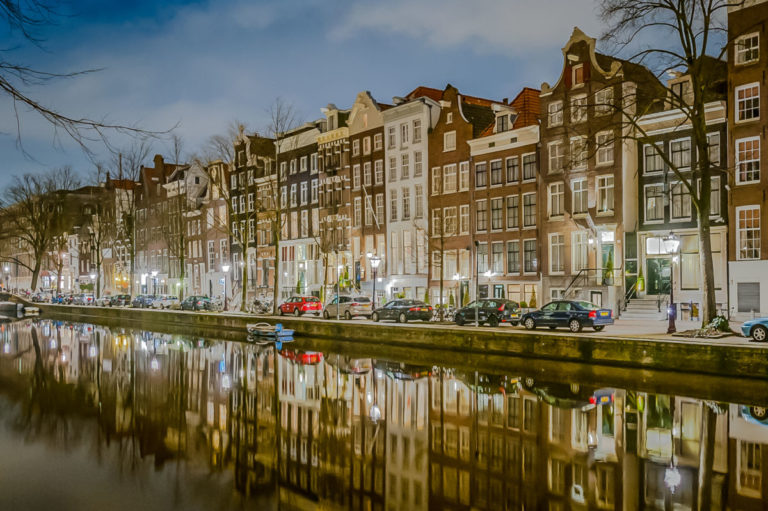
Hotel review, history, library, CoBrA art collection and photos
A history of Amsterdam’s canal district
Situated at Herengracht 341, you can find the cozy Ambassade Hotel Amsterdam, offering 56 rooms, a unique library, a rare floating experience as well as an outstanding CoBrA art collection.
The hotel is composed of ten 17th century canal houses which were built during the Golden Age of the Netherlands, when Amsterdam was an international art, commercial, science and technical center.
In 2010, the canal ring area of Amsterdam inside the Singelgracht became a UNESCO World Heritage Center. The canal district is an example of hydraulic and urban planning on a large scale, which survives in its entirety, with its old embankments and historic facade alignments. A large number of those buildings and structures are protected by national and municipal heritage listing.
The Herengracht has been built in two major phases around 1613 and 1664. Together with the Keizersgracht and the Prinsengracht, Herengracht builds the heart and pride of Amsterdam’s canal district.
Originally, the canals were not built as waterways for ships, but in order to drain the ground from its water in order to gain precious construction land.
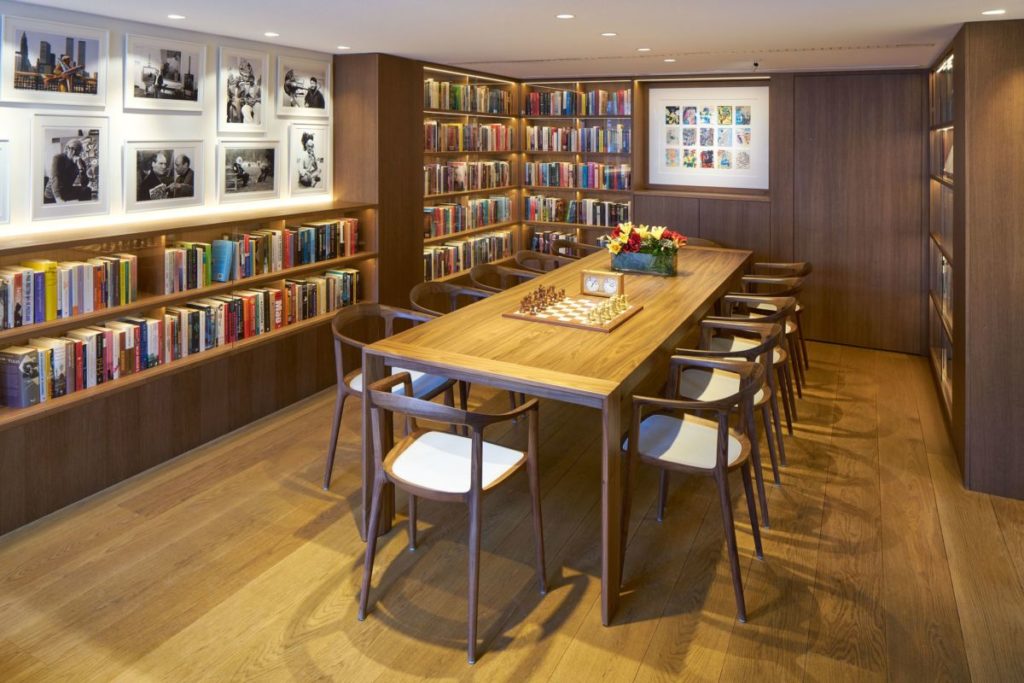
Ambassade Hotel CoBrA Lounge Meeting Room. Photograph copyright © Ambassade Hotel Amsterdam.
Ambassade Hotel Amsterdam
Ambassade Hotel opened in 1953 with only one canal house at Herengracht 349, which dates back to 1615. From its humble beginnings, the hotel was slowly enlarged and upgraded over the decades.
When I first stayed at Ambassade Hotel in 2006, it still had only three stars. Thanks to owner Wouter Schopman, an additional elevator was built, a full restaurant added and, in the past years, the Spanish architects Cruz y Ortiz, who stayed at the hotel while renovating the famous Rijksmuseum, offered to modernize the public areas, notably the reception, the brasserie-restaurant and the library, which was moved to another room where, in addition, a bar was added.
The style of the rooms has gradually been upgraded. Bed-linen by Fiore from Italy, elegant lamps and new bathrooms with black polished granite by the Cortlever company on the floor and as sink tables were added.
Since Ambassade Hotel has one private owner, the upgrade of the rooms comes gradually. Some bedrooms may still have a “funky” touch here and there. For instance, my 2017 Deluxe Canal Room no. 17 on the fourth floor had still a red bedroom carpet which does not fit with the rest of the decoration. On the other hand, I had the privilege to sleep with three Dutch artworks, including a 19th century view of Amsterdam by Willem Witsen and a great ink on paper work by Theo Wolvecamp.
Wifi is standard throughout the hotel and complimentary in all rooms. The TV offers some 100 channels, including CNN, CNBC, BBC1, BBC 2, BBC World, France 24, a dozen of German channels, including ARD, ZDF and 3sat, Dutch channels as well as many other TV stations in many languages from around the globe.
For breakfast, I enjoyed apple, orange, grapefruit, cranberry, apple and tomato juices as well as a great cheesecake with bananas, this time without becoming a victim of Murphy’s laws.
In addition to my Deluxe Canal Room no. 17, I had a look at two very recommendable great Superior Deluxe Canal Rooms with a bit more space than my accommodation: room 47 with a shower and a bathtub as well as room 93 with two showers.

A unique library © Ambassade Hotel Amsterdam.
A unique library
Ambassade Hotel features a unique library. Since its opening in the 1950s, the Dutch editors sent their foreign book agents to the hotel to sleep. With its continuous upgrading over the years, notably thanks to Wouter Schopman buying the hotel, the hotel was deemed fit to host writers from the 1980s onwards.
In 1986, the hotel introduced the custom that writers staying with them would sign a copy of their new book translated into Dutch. Therefore, in early 2017, the hotel library consisted already of some 4200 books, all signed by authors from over 76 countries who have stayed at Hotel Ambassade. A truly unique library.
Just a few names: Ian Kershaw’s monumental Hitler can be found in the library as well as books by V.S. Naipaul, Toni Morrison, Mario Vargas Llosa, Herta Müller, Günter Grass, Orhan Pamuk, José Saramago, Umberto Eco, Paul Auster, Isabel Allende and many others, including some Dutch writers such as Arthur Japin and Hella Haasse.
Because of its many illustrious guests, Ambassade Hotel can be found in some novels, including The Museum Guard by the Canadian Howard Norman and Tod eines Kritikers by Martin Walser.
Incidentally, hotel owner Wouter Schopman is also a publisher. He ownsthe publishing house Uitgeverij Samsara.
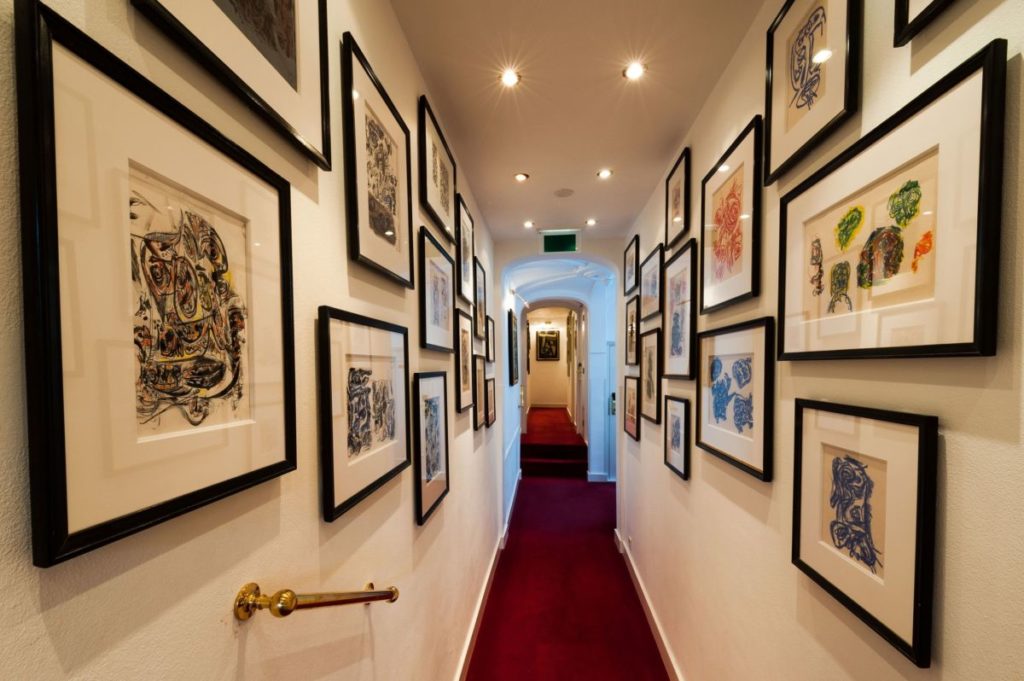
If you are an art lover, have a walk around all the public areas of the hotel, including all floor hallways. You can find great artworks by members of the CoBrA group. In addition, all rooms are decorated with CoBrA works of art. My Deluxe Canal View Room 17 on the fourth floor featured three artworks, including a 19th century view of Amsterdam by Willem Witsen and a great ink on paper work by Theo Wolvecamp, my favorite CoBrA artist, of whom you can find some ten other ink on paper works in the hallway of the fourth floor alone. Photo copyright © Ambassade Hotel Amsterdam.
The hotel’s CoBrA art collection
The hotel’s connection with the art world does not end here. In 1988, a visit to the exhibition Cobra, 40 years after of Karel van Stuijvenberg’s art collection at De Nieuwe Kerk in Amsterdam inspired hotel owner Wouter Schopman to start his remarkable CoBrA art collection.
Today, Hotel Ambassade features works by CoBrA artists such as Christian Dotremont, Asger Jorn, Henry Heerup, Ejler Bille, Pierre Alechinsky, Hugo Claus, Karel Appel, Corneille, Jean-Michel Atlan, my favorite Theo Wolvecamp and many others.
Incidentally, CoBrA is an acronym coined by the Belgian painter and poet Christian Dotrement, standing for Copenhagen, Brussels and Amsterdam, the three major cities were the avant-garde movement was active from 1948 until 1951. However, the movement’s manifesto, written by Christian Dotrement, La cause était entendue, was signed by all CoBrA founding members in Paris in 1948. It was a statement against the atmosphere of the period, which the artists considered to be sterile and authoritarian.
If you would like to know more about Wouter Schopman’s outstanding CoBrA collection, have a look at the book CoBrA on the canal by Esther Schreuder, which includes enlightening texts, including portraits and photographs of all artists, as well as reproductions of many artworks by the members of the avant-garde group.
In addition to CoBrA art, you can also find works by Dutch Impressionists such as Willem Witsen, Modernists such as Anton Heyboer and contemporary artists, including Marc Mulders.
Many CoBrA oil paintings can be admired at the brasserie (with its French cuisine), which also serves as breakfast restaurant. Have a look at Karel Appel’s oil painting with a “hole” in the center. That is from where the Dutch filmmaker Jan Vrijman pointed his camera at the artist in his short documentary The Reality of Karel Appel (1962).

Esther Schreuder: CoBrA on the canal. Publisher: Uitgeverij Samsara, Amsterdam, November 2013, 216 pages with many illustrations. Order the book from Amazon.co.uk and Amazon.de.
Koan Float
Koan Float is the hotel’s Float & Massage Center, situated just a few meters down the road at Herengracht 321. During my first stay in 2006, I could not use the float tank because of a broken wrist. Therefore, in January 2017, I was looking forward to my 45-minute floating experience, similar to the one in the Dead Sea, lying in a relaxation tank filled with water and 500kg of salt.
The therapy is officially known as Floating REST – Restricted Environmental Stimulation Therapy. It aims to minimize the level of environmental stimulation through the use of a specially designed tank filled with Epsom Salt water. Epsom Salt enhances your well-being through its major components: magnesium and sulfates. For more information, read through the documentation available at Koan Float. In short, in the closed tank, you can close your eyes, just float and relax. Let go and forget all your problems. At least for 45 minutes.
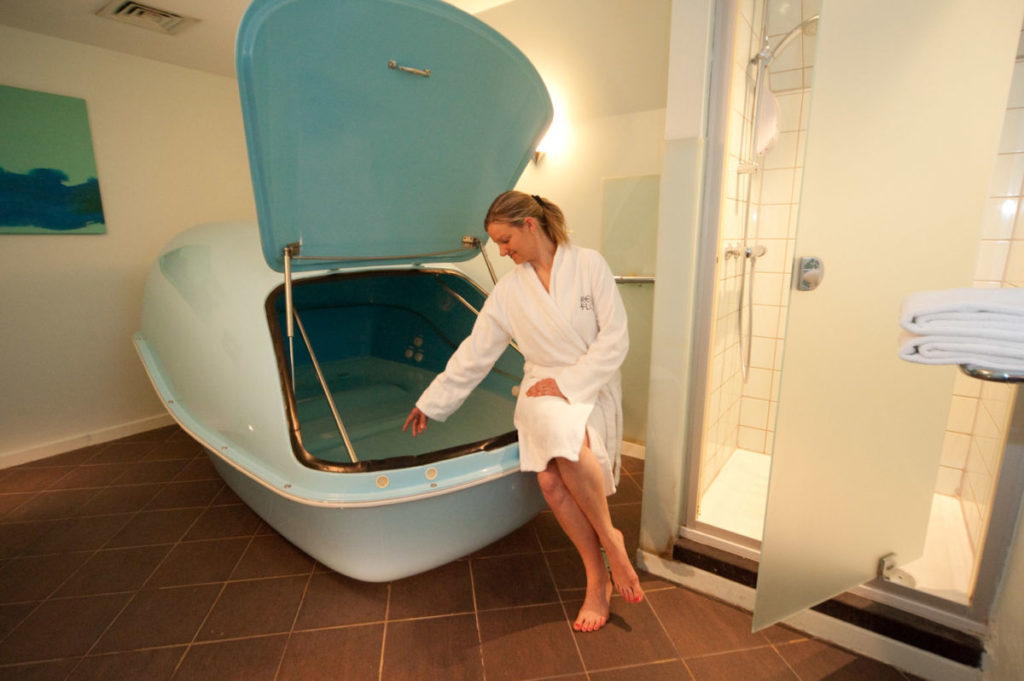
Just a few meters down the road, at Herengracht 321, you can find the hotel’s Float & Massage Center. I went there for a 45-minute floating experience, similar to the one in the Dead Sea, lying in a relaxation tank filled with water and 500kg of salt. Photo copyright © Ambassade Hotel Amsterdam.

View of a more colorful Canalside Deluxe Room. Photo copyright © Ambassade Hotel Amsterdam.
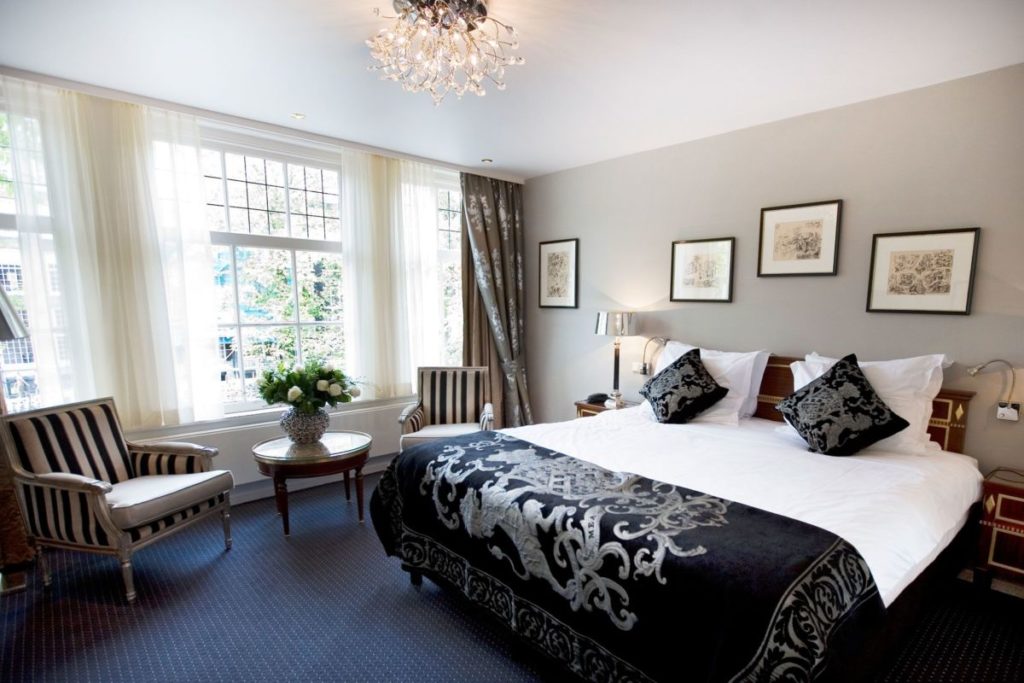
View of an Ambassade Hotel Canalside Superior Deluxe Room. Photo © Ambassade Hotel Amsterdam.

View of a Superior Deluxe Bathroom. All bathrooms I have seen are in this style. At least in my Canal View Room 17 with a bathtub and two sinks, as pictured here, the bathroom floor was heated. In January 2017, bathrooms featured BVLGARI White Tea amenities. Photo copyright © Ambassade Hotel Amsterdam. Right click show graphic for a larger image.
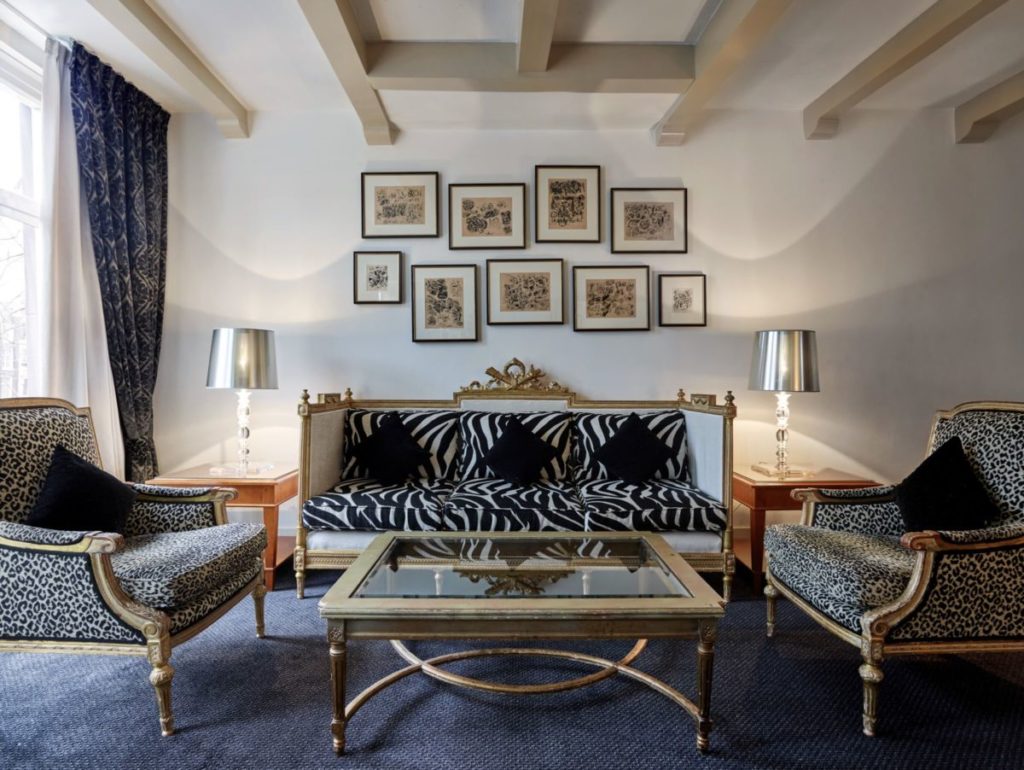
View of the Ambassade Hotel Apartment with its many artworks. Photo copyright © Ambassade Hotel Amsterdam. Books about Amsterdam at Amazon US and Amazon.co.uk.
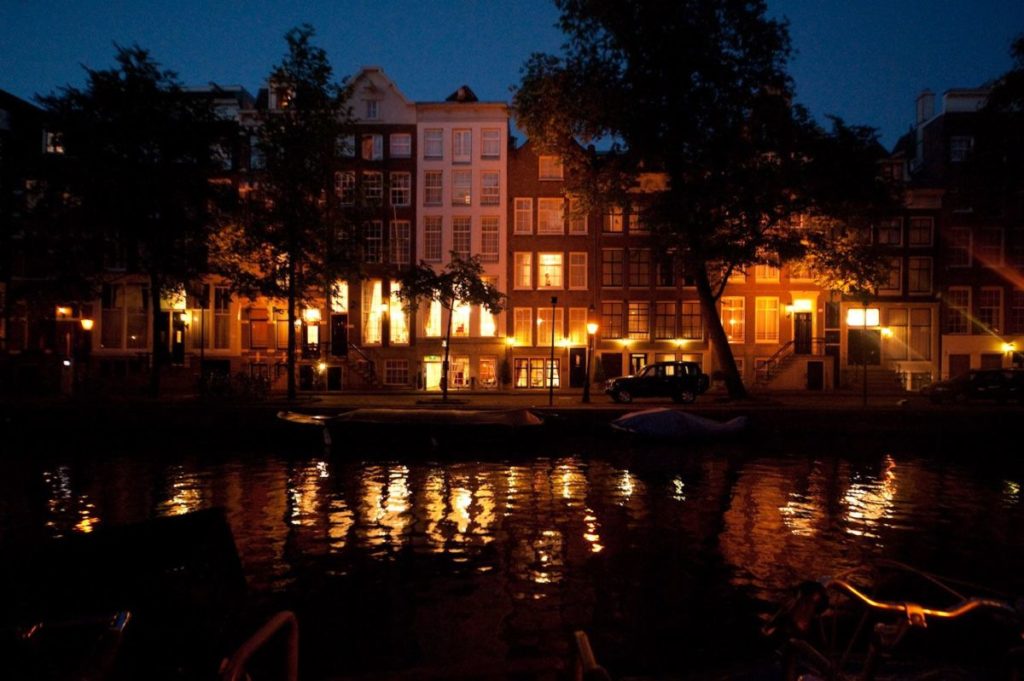
The hotel by night. Photo copyright © Ambassade Hotel Amsterdam.

The exterior by day. Photo copyright © Ambassade Hotel Amsterdam.
Updated on January 29, 2019: Ambassade Hotel Amsterdam has now only 56 rooms (when this article was originally written, in January 2017, they had 57).